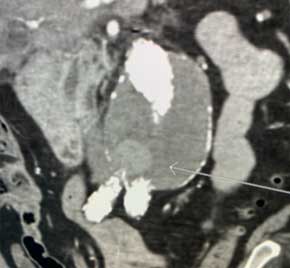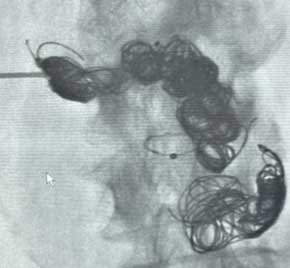Type II Endoleak embolized with EMBOLD™ Fibered Coils
In this case study, we explore the management of a Type II Endoleak utilizing Embold Fibered Coils. Patient with a history of prior endovascular aneurysm repair for an abdominal aortic aneurysm presented with a Type II Endoleak with an enlarging aneurysm sac. The medical team opted for a translumbar direct sac approach for embolization, necessitated by the tortuous transarterial route via the superior mesenteric artery (SMA). Employing an 18 G, 15 cm biopsy needle, the team accessed the endoleak cavity, followed by the coaxial placement of a 2.8 F microcatheter into the same cavity. A total of 12 Embold Fibered Coils were then delivered into the cavity. The endoleak cavity was successfully occluded.
Presentation
History of endovascular aneurysm repair for an abdominal aortic aneurysm in 2015 presenting with a Type II Endoleak with an enlarging aneurysm sac.
Intervention
A translumbar direct sac approach for embolization was chosen due to a long tortuous transarterial approach via the SMA. An 18 G, 15 cm biopsy needle was placed into the Endoleak cavity. A 2.8 F microcatheter was coaxially placed through the needle into the cavity and 12 Embold Fibered Coils were delivered into the cavity.
Outcome
Successful occlusion of the Endoleak cavity was achieved following translumbar direct sac embolization.
 Visualizing the Type II Endoleak
Visualizing the Type II Endoleak
 After Embold Fibered placement
After Embold Fibered placement
Anand Joshi, MD
Grant Medical Center
Columbus, OH
Results from case studies are not necessarily predictive of results in other cases. Results in other cases may vary.
